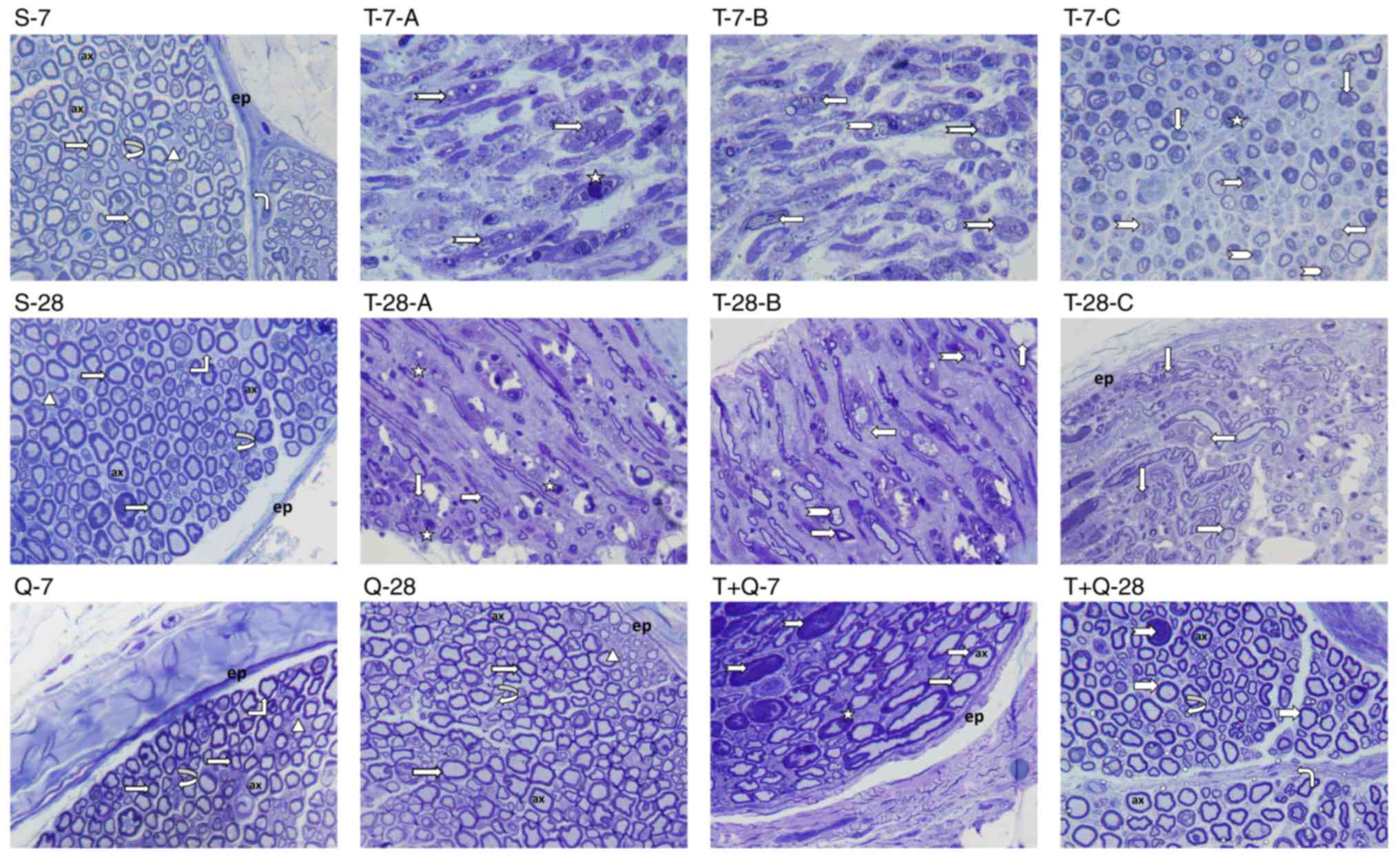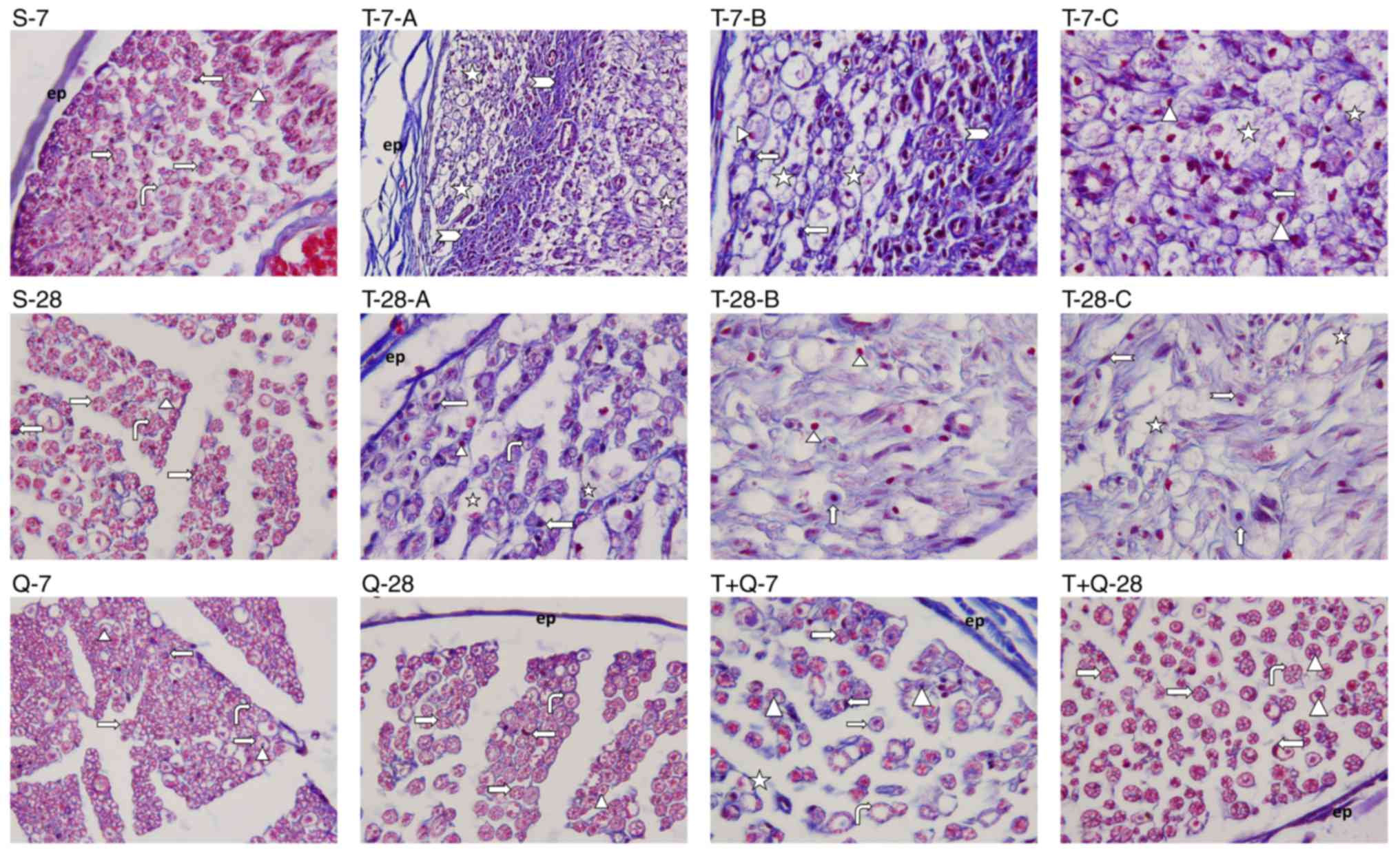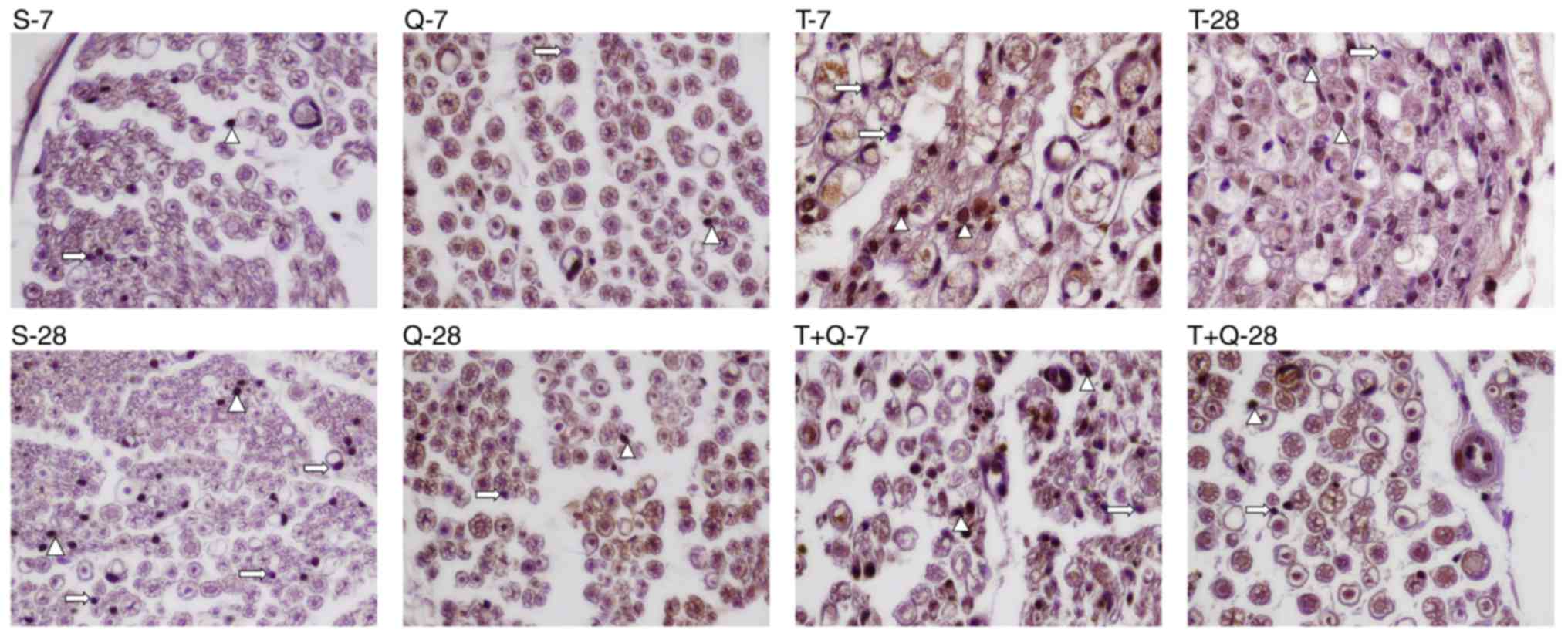|
1
|
Wang W, Li D, Li Q, Wang L, Bai G, Yang T,
Li Q, Zhu Z and Sun H: Erythropoietin promotes peripheral nerve
regeneration in rats by upregulating expression of insulin-like
growth factor-1. Arch Med Sci. 11:433–437. 2015. View Article : Google Scholar : PubMed/NCBI
|
|
2
|
Yüce S, Cemal Gökçe E, Işkdemir A, Koç ER,
Cemil DB, Gökçe A and Sargon MF: An experimental comparison of the
effects of propolis, curcumin, and methylprednisolone on crush
injuries of the sciatic nerve. Ann Plast Surg. 74:684–692. 2015.
View Article : Google Scholar : PubMed/NCBI
|
|
3
|
Yildirim AE, Dalgic A, Divanlioglu D,
Akdag R, Cetinalp NE, Alagoz F, Helvacioglu F, Take G, Guvenc Y,
Koksal I and Belen AD: Biochemical and histopathological effects of
catechin on experimental peripheral nerve injuries. Turk Neurosurg.
25:453–460. 2015.PubMed/NCBI
|
|
4
|
Gao Y, Weng C and Wang X: Changes in nerve
microcirculation following peripheral nerve compression. Neural
Regen Res. 8:1041–1047. 2013.PubMed/NCBI
|
|
5
|
Roglio I, Bianchi R, Gotti S, Scurati S,
Giatti S, Pesaresi M, Caruso D, Panzica GC and Melcangi RC:
Neuroprotective effects of dihydroprogesterone and progesterone in
an experimental model of nevre crush injury. Neuroscience.
155:673–685. 2008. View Article : Google Scholar : PubMed/NCBI
|
|
6
|
Beck-Broichsitter BE, Lamia A, Geuna S,
Fregnan F, Smeets R, Becker ST and Sinis N: Does pulsed magnetic
field therapy influence nerve regeneration in the median nerve
model of the rat? Biomed Res Int 2014. 4017602014.
|
|
7
|
Schmelzer JD, Zochodne DW and Low PA:
Ischemic and reperfusion injury of rat peripheral nerve. Proc Natl
Acad Sci USA. 86:pp. 1639–1642. 1989; View Article : Google Scholar : PubMed/NCBI
|
|
8
|
Waseem M and Parvez S: Neuroprotective
activities of curcumin and Quercetin with potential relevance to
mitochondrial dysfunction induced by oxaliplatin. Protoplasma.
253:417–430. 2016. View Article : Google Scholar : PubMed/NCBI
|
|
9
|
Arikan S, Ersan I, Karaca T, Kara S,
Gencer B, Karaboga I and Hasan Ali T: Quercetin protects the retina
by reducing apoptosis due to ischemia-reperfusion injury in a rat
model. Arq Bras Oftalmol. 78:100–104. 2015. View Article : Google Scholar : PubMed/NCBI
|
|
10
|
Yao RQ, Qi DS, Yu HL, Liu J, Yang LH and
Wu XX: Quercetin attenuates cell apoptosis in focal cerebral
ischemia rat brain via activation of BDNF-TrkB-PI3K/Akt signaling
pathway. Neurochem Res. 37:2777–2786. 2012. View Article : Google Scholar : PubMed/NCBI
|
|
11
|
Sharma DR, Wani WY, Sunkaria A, Kandimalla
RJ, Verma D, Cameotra SS and Gill KD: Quercetin protects against
chronic aluminum-induced oxidative stress and ensuing biochemical,
cholinergic, and neurobehavioral impairments in rats. Neurotox Res.
23:336–357. 2013.PubMed/NCBI
|
|
12
|
Guide for the Care and Use of Laboratory
Animals, . National Research Council (US): Committee for the Update
of the Guide for the Care and Use of Laboratory Animals. 8th.
National Academies Press (US); Washington, DC: 2011
|
|
13
|
Ferreira PE, Lopes CR, Alves AM, Alves ÉP,
Linden DR, Zanoni JN and Buttow NC: Diabetic neuropathy: An
evaluation of the use of quercetin in the cecum of rats. World J
Gastroenterol. 19:6416–6426. 2013. View Article : Google Scholar : PubMed/NCBI
|
|
14
|
Hirata K and Kawabuchi M: Myelin
phagocytosis by macrophages and nonmacrophages during wallerian
degeneration. Microsc Res Tech. 57:541–547. 2002. View Article : Google Scholar : PubMed/NCBI
|
|
15
|
Mirajullah M and Shen X: Schwann cells:
Leader of nervenkitt. J Ayub Med Coll Abbottabad. 14:30–33.
2002.PubMed/NCBI
|
|
16
|
Burnett MG and Zager EL: Pathophysiology
of peripheral nerve injury: A brief review. Neurosurg Focus.
16:E12004. View Article : Google Scholar : PubMed/NCBI
|
|
17
|
Di Scipio F, Raimondo S, Tos P and Geuna
S: A simple protocol for paraffin-embedded myelin sheath staining
with osmium tetroxide for light microscope observation. Microsc Res
Tech. 71:497–502. 2008. View Article : Google Scholar : PubMed/NCBI
|
|
18
|
Yagi K: Lipid peroxides related radicals
in clinical medicine free radicals in diagnostic medicine. Adv Exp
Med Biol. 366:1–15. 1994. View Article : Google Scholar : PubMed/NCBI
|
|
19
|
Mihara M and Uchiyama M: Determination of
malonaldehyde precursor in tissues by thiobarbituric acid test.
Anal Biochem. 86:271–278. 1978. View Article : Google Scholar : PubMed/NCBI
|
|
20
|
Góth L: A simple method for determination
of serum catalase activity and revision of reference range. Clin
Chim Acta. 196:143–151. 1991. View Article : Google Scholar : PubMed/NCBI
|
|
21
|
Sun Y, Oberley LW and Li Y: A simple
method for clinical assay of superoxide dismutase. Clin Chem.
34:497–500. 1988.PubMed/NCBI
|
|
22
|
Ellman GL: Tissue sulphydryl groups. Arch
Biochem Biophys. 82:70–77. 1959. View Article : Google Scholar : PubMed/NCBI
|
|
23
|
Karşıdağ S, Özcan A, Sahin S, Karşidağ S,
Kabukçuoğlu F, Uğurlu K and Baş L: Electrophysiologic and
histopathologic evaluation of peripheral nerve regeneration at
different nerve segments and with different repair techniques. Acta
Orthop Traumatol Turc. 42:278–283. 2008.(In Turkish). View Article : Google Scholar : PubMed/NCBI
|
|
24
|
Tos P, Ronchi G, Papalia I, Sallen V,
Legagneux J, Geuna S and Giacobini-Robecchi MG: Chapter 4: Methods
and protocols in peripheral nevre regeneration experimental
research: Part I-experimental models. Int Rev Neurobiol. 87:47–79.
2009. View Article : Google Scholar : PubMed/NCBI
|
|
25
|
Vogelaar CF, Vrinten DH, Hoekman MF,
Brakkee JH, Burbach JP and Hamers FP: Sciatic nerve regeneration in
mice and rats: Recovery of sensory innervation is followed by a
slowly retreating neuropathic pain-like syndrome. Brain Res.
1027:67–72. 2004. View Article : Google Scholar : PubMed/NCBI
|
|
26
|
Glenn TD and Talbot WS: Signals regulating
myelination in peripheral nerves and the Schwann cell response to
injury. Curr Opin Neurobiol. 23:1041–1048. 2013. View Article : Google Scholar : PubMed/NCBI
|
|
27
|
Li R, Wu J, Lin Z, Nangle MR, Li Y, Cai P,
Liu D, Ye L, Xiao Z, He C, et al: Single injection of a novel nerve
growth factor coacervate improves structural and functional
regeneration after sciatic nerve injury in adult rats. Exp Neurol.
288:1–10. 2017. View Article : Google Scholar : PubMed/NCBI
|
|
28
|
Wang Y, Shan Q, Meng Y, Pan J and Yi S:
Mrpl10 and Tbp are suitable reference genes for peripheral nerve
crush injury. Int J Mol Sci. 18:pii: E2632017. View Article : Google Scholar
|
|
29
|
Galtrey CM and Fawcett JW: The role of
chondroitin sulfate proteoglycans in regeneration and plasticity in
the central nervous system. Brain Res Rev. 54:1–18. 2007.
View Article : Google Scholar : PubMed/NCBI
|
|
30
|
Yin ZS, Zhang H, Bo W and Gao W:
Erythropoietin promotes functional recovery and enhances nerve
regeneration after peripheral nerve injury in rats. AJNR Am J
Neuroradiol. 31:509–515. 2010. View Article : Google Scholar : PubMed/NCBI
|
|
31
|
Gigo-Benato D, Russo TL, Tanaka EH, Assis
L, Salvini TF and Parizotto NA: Effects of 660 and 780 nm low-level
laser therapy on neuromuscular recovery after crush injury in rat
sciatic nerve. Lasers Surg Med. 42:673–682. 2010. View Article : Google Scholar : PubMed/NCBI
|
|
32
|
Gjurasin M, Miklic P, Zupancic B, Perovic
D, Zarkovic K, Brcic L, Kolenc D, Radic B, Seiwerth S and Sikiric
P: Peptide therapy with Pentadecapeptide BPC 157 in traumatic nerve
injury. Regul Pept. 160:33–41. 2010. View Article : Google Scholar : PubMed/NCBI
|
|
33
|
Noorafshan A, Omidi A and Karbalay-Doust
S: Curcumin protects the dorsal root ganglion and sciatic nerve
after crush in rat. Pathol Res Pract. 207:577–582. 2011. View Article : Google Scholar : PubMed/NCBI
|
|
34
|
Jiang X, Ma J, Wei Q, Feng X, Qiao L, Liu
L, Zhang B and Yu W: Effect of frankincense extract on nerve
recovery in the rat sciatic nerve damage model. Evid Based
Complement Alternat Med. 2016:36172162016. View Article : Google Scholar : PubMed/NCBI
|
|
35
|
Morani AS and Bodhankar SL:
Neuroprotective effect of vitamin E acetate in models of
mononeuropathy in rats. Neuroanatomy. 7:33–37. 2008.
|
|
36
|
Smith D, Tweed C, Fernyhough P and Glazner
GW: Nuclear factor-kappaB activation in axons and Schwann cells in
experimental sciatic nevre injury and its role in modulating axon
regeneration: Studies with etanercept. J Neuropathol Exp Neurol.
68:691–700. 2009. View Article : Google Scholar : PubMed/NCBI
|
|
37
|
Maeda T, Kiguchi N, Kobayashi Y, Ozaki M
and Kishioka S: Pioglitazone attenuates tactile allodynia and
thermal hyperalgesia in mice subjected to peripheral nerve injury.
J Pharmacol Sci. 108:341–347. 2008. View Article : Google Scholar : PubMed/NCBI
|
|
38
|
Goraca A, Ciejka E and Piechota A: Effects
of extremely low frequency magnetic field on the parameters of
oxidative stress in heart. J Physiol Pharmacol. 61:333–338.
2010.PubMed/NCBI
|
|
39
|
Ragy MM: Effect of exposure and withdrawal
of 900-MHz electromagnetic waves on brain, kidney and liver
oxidative stress and some biochemical parameters in male rats.
Electromagn Biol Med. 34:279–284. 2015. View Article : Google Scholar : PubMed/NCBI
|
|
40
|
Yurekli AI, Ozkan M, Kalkan T, Saybasili
H, Tuncel H, Atukeren P, Gumustas K and Seker S: GSM base station
electromagnetic radiation and oxidative stress in rats. Electromagn
Biol Med. 25:177–188. 2006. View Article : Google Scholar : PubMed/NCBI
|
|
41
|
Tkalec M, Stambuk A, Srut M, Malarić K and
Klobučar GI: Oxidative and genotoxic effects of 900 MHz
electromagnetic fields in the earthworm Eisenia fetida. Ecotoxicol
Environ Saf. 90:7–12. 2013. View Article : Google Scholar : PubMed/NCBI
|
|
42
|
Meral I, Mert H, Mert N, Deger Y, Yoruk I,
Yetkin A and Keskin S: Effects of 900-MHz electromagnetic field
emitted from cellular phone on brain oxidative stres and some
vitamin levels of guinea pigs. Brain Res. 1169:120–124. 2007.
View Article : Google Scholar : PubMed/NCBI
|
|
43
|
Celino FT, Yamaguchi S, Miura C, Ohta T,
Tozawa Y, Iwai T and Miura T: Tolerance of spermatogonia to
oxidative stress is due to high levels of Zn and Cu/Zn superoxide
dismutase. PLoS One. 6:e169382011. View Article : Google Scholar : PubMed/NCBI
|
|
44
|
Hall ED and Braughler JM: Effects of
intravenous methylprednisolone on spinal cord lipid peroxidation
and Na+ + K+)-ATPase activity. Dose-response analysis during 1st
hour after contusion injury in the cat. J Neurosurg. 57:247–253.
1982. View Article : Google Scholar : PubMed/NCBI
|
|
45
|
Lanza C, Raimondo S, Vergani L, Catena N,
Sénès F, Tos P and Geuna S: Expression of antioxidant molecules
after peripheral nerve injury and regeneration. J Neurosci Res.
90:842–848. 2012. View Article : Google Scholar : PubMed/NCBI
|
|
46
|
Ozturk O, Tezcan AH, Adali Y, Yıldırım CH,
Aksoy O, Yagmurdur H and Bilge A: Effect of ozone and
methylprednisolone treatment following crush type sciatic nerve
injury. Acta Cir Bras. 31:730–735. 2016. View Article : Google Scholar : PubMed/NCBI
|
|
47
|
Gutteridge JM: Lipid peroxidation and
antioxidants as biomarkers of tissue damage. Clin Chem.
41:1819–1828. 1995.PubMed/NCBI
|
|
48
|
Galloway EB III, Jensen RL, Dailey AT,
Thompson BG and Shelton C: Role of topical steroids in reducing
dysfunction after nevre injury. Laryngoscope. 110:1907–1910. 2000.
View Article : Google Scholar : PubMed/NCBI
|
|
49
|
Lee M, Doolabh VB, Mackinnon SE and Jost
S: FK506 promotes functional recovery in crushed rat sciatic nerve.
Muscle Nerve. 23:633–640. 2000. View Article : Google Scholar : PubMed/NCBI
|
|
50
|
Halliwell B and Gutteridge JM: Role of
free radicals and catalytic metal ions in human disease: An
overview. Methods Enzymol. 186:1–85. 1990. View Article : Google Scholar : PubMed/NCBI
|
|
51
|
da Silva EL, Piskula MK, Yamamoto N, Moon
JH and Terao J: Quecetin metabolites inhibit copper ion-induced
lipid peroxidation in rat plasma. FEBS Lett. 430:405–408. 1998.
View Article : Google Scholar : PubMed/NCBI
|
|
52
|
Elik M, Serdaroğlu G and Özkan R:
Mİrisetin ve kuersetin bileşiklerinin antioksidan etkinliklerinin
dft yöntemiyle incelenmesi. CÜ Fen Bil Dergisi. 28:53–65. 2007.
|
|
53
|
Heo HJ and Lee CY: Protective effects of
quercetin and vitamin C against oxidative stress-induced
neurodegeneration. J Agric Food Chem. 52:7514–7517. 2004.
View Article : Google Scholar : PubMed/NCBI
|
|
54
|
Chen MM, Qin J, Chen SJ, Yao LM, Zhang LY,
Yin ZQ and Liao H: Quercetin promotes motor and sensory function
recovery following sciatic nerve-crush injury in C57BL/6J mice. J
Nutr Biochem. 46:57–67. 2017. View Article : Google Scholar : PubMed/NCBI
|
|
55
|
Hu QH, Wang C, Li JM, Zhang DM and Kong
LD: Allopurinol, rutin, and Quercetin attenuate hyperuricemia and
renal dysfunction in rats ınduced by fructose ıntake: Renal
organicion transporter ınvolvement. AM J Physiol Renal Physiol.
297:F1080–F1091. 2009. View Article : Google Scholar : PubMed/NCBI
|
|
56
|
Raju TA, Lakshmi AN, Anand T, Rao LV and
Sharma G: Protective effects of Quercetin during ınfluenza
virus-ınduced oxidative stres. Asia Pac J Clin Nutr. 9:314–317.
2000. View Article : Google Scholar : PubMed/NCBI
|
|
57
|
Pawlikowska-Pawlega B, Gruszecki WI,
Misiak LE and Gawron A: The study of the quercetin action on human
erythrocyte membranes. Biochem Pharmacol. 66:605–612. 2003.
View Article : Google Scholar : PubMed/NCBI
|
|
58
|
Sugantha Priya E, Selvakumar K, Bavithra
S, Elumalai P, Arunkumar R, Raja Singh P, Brindha Mercy A and
Arunakaran J: Anti-cancer activity of quercetin in neuroblastoma:
An in vitro approach. Neurol Sci. 35:163–170. 2014.
View Article : Google Scholar : PubMed/NCBI
|
|
59
|
Gholami M, Khayat ZK, Anbari K, Obidavi Z,
Varzi A, Boroujeni MB, Alipour M, Niapoor A and Gharravi AM:
Quercetin ameliorates peripheral nerve ischemia-reperfusion injury
through the NF-kappa B pathway. Anat Sci Int. 92:330–337. 2017.
View Article : Google Scholar : PubMed/NCBI
|
|
60
|
Yu J, Zhang Y, Sun S, Shen J, Qiu J, Yin
X, Yin H and Jiang S: Inhibitory effects of astragaloside IV on
diabetic peripheral neuropathy in rats. Can J Physiol Pharmacol.
84:579–587. 2006. View Article : Google Scholar : PubMed/NCBI
|
|
61
|
Cheng CY, Yao CH, Liu BS, Liu CJ, Chen GW
and Chen YS: The role of astragaloside in regeneration of the
peripheral nerve system. J Biomed Mater Res A. 76:463–469. 2006.
View Article : Google Scholar : PubMed/NCBI
|
|
62
|
Zhang X and Chen J: The mechanism of
astragaloside IV promoting sciatic nerve regeneration. Neural Regen
Res. 8:2256–2265. 2013.PubMed/NCBI
|
|
63
|
Tohda C, Tamura T, Matsuyama S and Komatsu
K: Promotion of axonal maturation and prevention of memory loss in
mice by extracts of Astragalus mongholicus. Br J Pharmacol.
149:532–541. 2006. View Article : Google Scholar : PubMed/NCBI
|
|
64
|
Pilotte N, Papaiakovou M, Grant JR,
Bierwert LA, Llewellyn S, McCarthy JS and Williams SA: Improved
PCR-based detection of soil transmitted helminth infections using a
next-generation sequencing approach to assay design. PLoS Negl Trop
Dis. 10:e00045782016. View Article : Google Scholar : PubMed/NCBI
|
|
65
|
Klasan GS, Ivanac D, Erzen DJ, Picard A,
Takasawa S, Peharec S, Arbanas J, Girotto D and Jerkovic R: Reg3G
gene expression in regenerating skeletal muscle and corresponding
nerve. Muscle Nerve. 49:61–68. 2014. View Article : Google Scholar : PubMed/NCBI
|
|
66
|
Al-Jumaily M, Kozlenkov A, Mechaly I,
Fichard A, Matha V, Scamps F, Valmier J and Carroll P: Expression
of three distinct families of calcium-activated chloride channel
genes in the mouse dorsal root ganglion. Neurosci Bull. 23:293–299.
2007. View Article : Google Scholar : PubMed/NCBI
|












